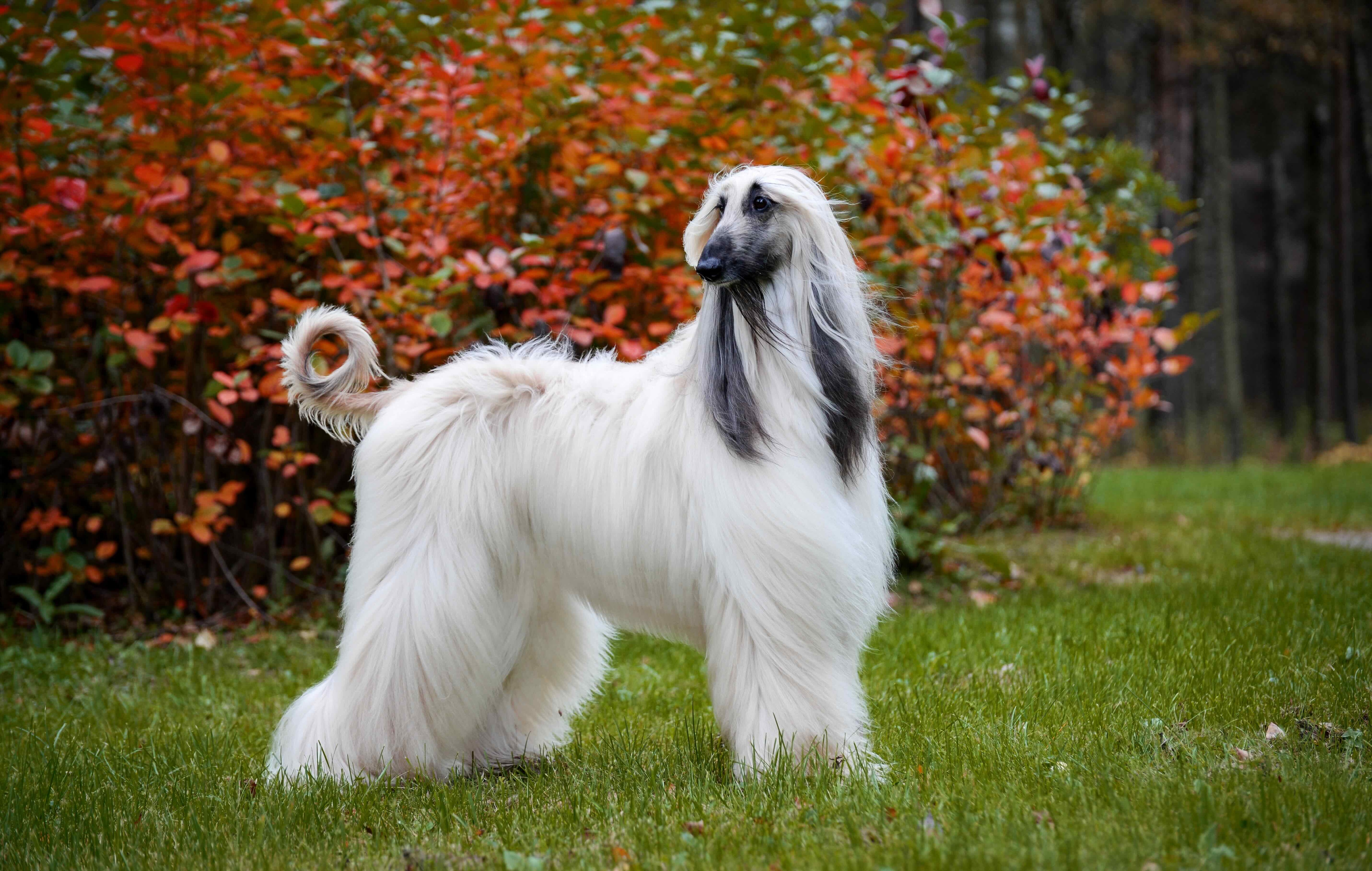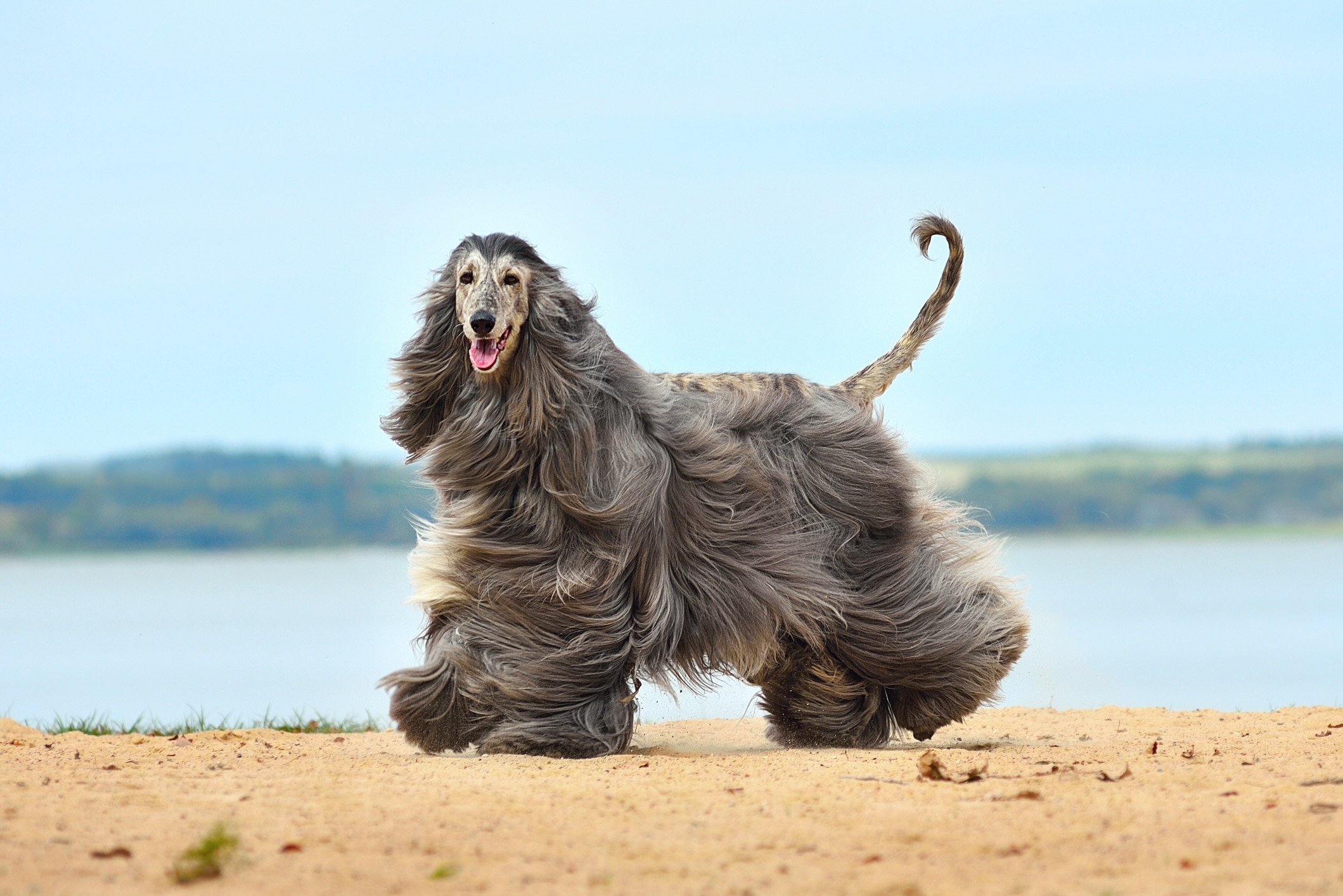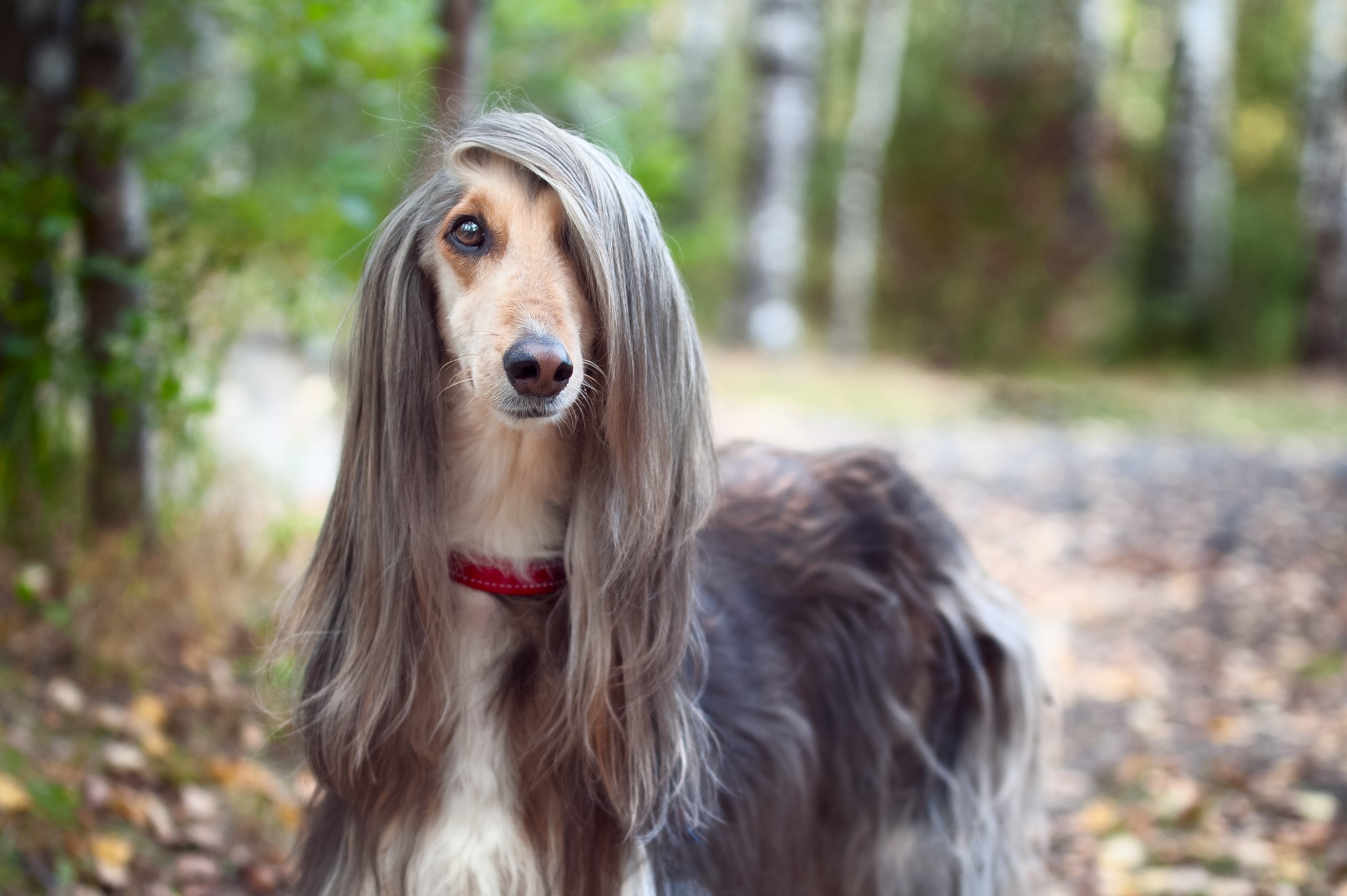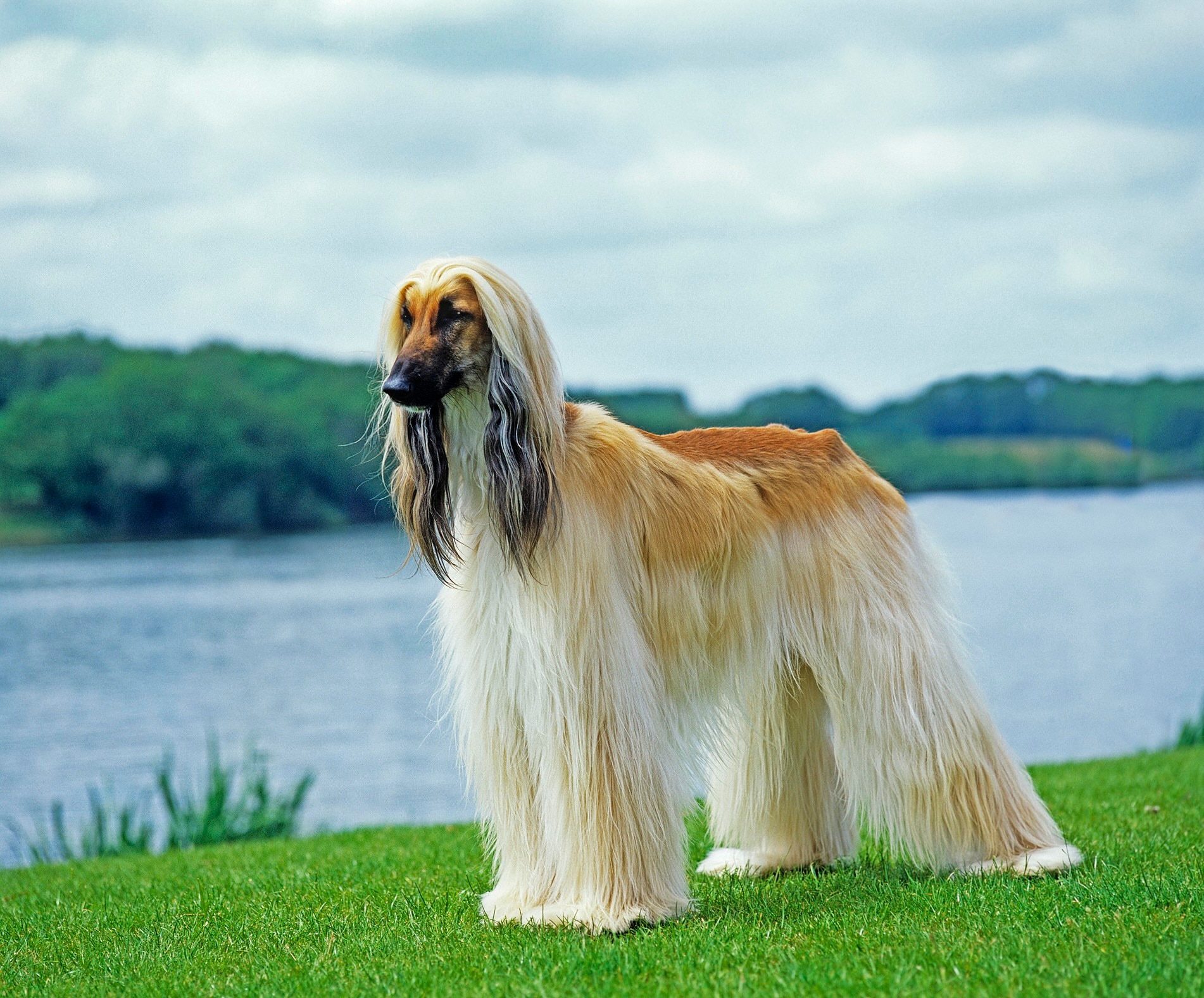Afghan Hound
Pierre Aden/iStock / Getty Images Plus via Getty Images
The Afghan Hound is a sight hound with sharp eyesight and quick feet, which makes these dogs excellent at hunting small game and well-suited for modern dog sports like lure coursing.
“They originated in Afghanistan and were bred to be an independent hunter, which explains their independent nature,” says Sandra Frei, a board member of the Afghan Hound Club of America (AHCA), American Kennel Club judge, and longtime Afghan Hound breeder.
An adult Afghan Hound dog stands 25–27 inches tall and weighs 50–60 pounds. The most striking feature of the breed is the long, silky coat that comes in a range of colors, including black, cream, blue, tan, red, and brindle.
Caring for an Afghan Hound
Afghan Hounds have an independent nature and require consistent training to build a strong bond with their human family members. With long legs and a high prey drive, these dogs require regular daily exercise—like a long walk or a jog.
But these dogs should never be let loose in an unfenced area. Afghan Hounds are known to be high jumpers, so it’s worth considering a tall fence to keep them safe.
The Afghan Hound might be considered more high-maintenance than the most popular family dog breeds, but the breed’s unique disposition, impressive athleticism, and striking looks are worth the effort for committed pet parents.
Afghan Hound Health Issues

Afghan Hounds are generally healthy dogs, and good breeding practices help improve the health and longevity of the breed. “Responsible breeders will test the hips, eyes, and thyroid to make sure they are clear before breeding them,” says Frei.
That said, there are a few Afghan Hound health issues to be aware of.
Chylothorax
Chylothorax is a condition that occurs when chyle, a milky lymphatic fluid formed in the small intestines, leaks into the chest cavity. As it fills the chest, it puts pressure on organs like the heart and lungs and causes blockages in the lymphatic vessels.
As this happens, the vessels dilate, causing inflammation and scar tissue to the lungs and frequently resulting in breathing problems. In addition, loss of the leaked lymphatic fluid can weaken the immune system.
The disease is more common in Afghan Hounds than other breeds. However, Frei says it’s not an epidemic within the breed.
Feeding your Afghan Hound a low-fat diet is one way to lower the risk of chylothorax. Always discuss your dog’s diet with your veterinarian.
Gastric Dilation and Volvulus
Like other sight hounds, Afghan Hounds have a deep chest that can increase the likelihood of bloat.
Bloat is when the dog’s stomach expands with gas, cutting off blood supply to the abdomen or the stomach. If the stomach also twists, it’s a potentially deadly situation known as gastric dilation-volvulus (GDV).
If you see symptoms of GDV in your Afghan Hound—such as an enlarged abdomen, gagging and retching without results, pain, restlessness, or a decreased appetite—seek emergency care immediately.
To help prevent bloat, Joy Atkins-Miller, a longtime enthusiast of the breed and a member of the Afghan Hound Club of St. Louis, advises limiting your dog’s intense activity around mealtimes, and monitoring how fast they eat and drink.
It’s important to wait at least an hour after your Afghan Hound eats before letting them exercise, and that their meals are not too large.
Because Afghan Hounds are prone to bloat, you may want to discuss gastropexy surgery with your veterinarian. This preventative surgery can be done at the same time as spay/neuter surgery and sutures the stomach to the abdominal wall. This helps prevent the stomach from twisting.
What To Feed an Afghan Hound
An Afghan Hound dog should be fed a high-quality, well-balanced dog food formula. Pick a dog food that meets the nutritional standards set by the Association of American Feed Control Officials (AAFCO), such as Purina®, Hill’s®, or Royal Canin®.
It’s also important to choose a dog food that is appropriate for your dog’s life stage, since nutritional needs for Afghan Hound puppies differ from those for adult and senior dogs.
How To Feed an Afghan Hound
A mature Afghan Hound should be fed on a consistent schedule—typically two meals a day. Because this breed has a body structure that makes them more prone to bloat, ensure that meals aren’t eaten too quickly. If your pet tends to gulp down food, help your dog eat more slowly with a slow-feeder bowl or a food-dispensing toy.
How Much Should You Feed an Afghan Hound?
Take care to avoid overfeeding your Afghan Hound, as this can lead to obesity. At the same time, you need to supply your dog with enough calories to support a healthy body weight and activity level.
Follow the feeding guidelines suggested by the dog food formula you choose, and adjust based on factors specific to your dog, like age, activity level, and overall health. Your veterinarian can provide specific guidance on how much to feed your dog based on your Afghan Hound’s specific physiology.
Nutritional Tips for Afghan Hounds
A healthy Afghan Hound fed an AAFCO-compliant diet is likely taking in all needed nutrients and may not require additional supplements. But if you have specific health concerns, it’s best to consult your veterinarian for supplement suggestions.
Behavior and Training Tips for Afghan Hounds
Afghan Hound Personality and Temperament

The Afghan Hound temperament could best be described as reserved. The official breed standard describes the dogs as “aloof and dignified,” without being shy. They might not be outgoing and friendly when meeting new people, but they form close bonds with their family.
As sight hounds, these dogs have a strong prey drive and may chase smaller animals like squirrels and rabbits. But they can live well with other household pets, if your Afghan Hound is properly socialized and taught from an early age to not chase cats.
Due to their prey drive nature, it’s important to monitor them around children, especially young children, and to always teach kids how to interact safely with dogs.
Afghan Hound Behavior
The Afghan Hound is aloof by choice—not because the dog is overly anxious or fearful. They tend to be reserved around new people in unfamiliar situations, taking the time to observe the situation, and preferring to approach and engage on their own terms.
In general, Afghan Hounds don’t tend to be overly vocal and aren’t frequent barkers. But because they are sight hounds and may be tempted to chase smaller animals, always keep your dog on a leash or within a fenced area when outside.
Afghan Hound Training
As with all dogs, consistency is key to training an Afghan Hound puppy. “You need to have patience and perseverance to be successful,” says Frei. Positive reinforcement is the best way to engage with an Afghan Hound.
Atkins-Miller says the breed’s independent nature requires taking an innovative approach to training. “You need to be more clever than your hound, tricking her into thinking it is her idea—and then a reward (usually of food) needs to be given quickly for reinforcement,” she says.
Along with training, you can socialize your Afghan Hound puppy as soon as you bring them home by exposing them to new people, animals, environments, and sounds. This helps your dog establish tolerance to new stimuli and remain calm and well-behaved.
Frei says frequent walks, enrolling in a puppy class, and a trip to pet-friendly stores are all excellent ways to socialize an Afghan Hound puppy. Ask your vet for advice on socialization.
Fun Activities for Afghan Hounds
-
Neighborhood walks
Afghan Hound Grooming Guide

The Afghan Hound has a long and thick coat of silky, fine hair. The hair is somewhat shorter on the back; this is often referred to as the dog’s saddle. The face and muzzle also have short hair, but a topknot of long hair cascades around the Afghan’s face and ears, forming an essential aspect of the Afghan’s stately appearance.
This elegant coat requires more than the usual amount of time spent on brushing and bathing a dog, and you may need the help of a professional groomer to keep it maintained.
“The Afghan Hound is a high-maintenance breed if you want to keep them in full coat,” says Frei. Because extensive grooming is part of life with this breed, Frei emphasizes that it’s important to acclimate Afghan Hound puppies to the routine of bathing and blow-drying from an early age.
Skin Care
There are no specific skin care needs associated with the Afghan Hound breed, but they do benefit from more frequent bathing than some other dog breeds.
Bathing your dog at least once every week or two is important for keeping the coat clean and conditioned, and it’s usually recommended to blow-dry the coat after a bath.
Coat Care
According to the Afghan Hound Club of America (AHCA), these dogs require a few hours of brushing each week. Regular brushing will distribute healthy oils throughout the coat and remove snarls, which can quickly become mats because of the thick and fine nature of the Afghan’s coat.
Frei says a good-quality pin brush and comb are essential grooming tools. In addition, some Afghan Hound pet parents use a snood to contain the dog’s long hair while eating. The snood is a fabric tube that slides over the head and keeps the hair and ears pulled back.
For pet parents who want to reduce the amount of daily grooming, you can clip your Afghan Hound’s coat to be shorter and more manageable, Frei says.
Eye Care
During routine grooming, check an Afghan Hound’s eyes for signs of injury or infection—like redness, discharge, or cloudiness. If you notice a problem, contact your veterinarian immediately.
Ear Care
The long, folded ears of the Afghan Hound could conceal an issue from sight, so it’s important to frequently lift the ear and check for excessive ear wax, redness, or discharge.
Monitor your dog’s ears for signs of an ear infection, and contact your vet if you notice warning signs like debris, redness, or a bad odor. Make it a practice to regularly handle the ears from an early age so you can easily perform this health check while petting or grooming your dog.
Considerations for Pet Parents

The Afghan Hound personality requires diligence and consistency in training, and the breed’s physical attributes necessitate regular grooming and daily exercise. These dogs are not people-pleasers by nature, but they can be affectionate, loyal, and entertaining—especially within the family circle.
Experts say first-time pet parents can be successful Afghan Hound dog caretakers, but they emphasize the importance of doing thorough research before bringing home an Afghan Hound puppy. Frei points out that a good breeder or a mentor who is experienced with Afghan Hounds can be a valuable resource.
Afghan Hound FAQs
Is an Afghan Hound a good family dog?
The Afghan Hound generally chooses a favorite person, but this breed can still be a good family dog, especially with proper training and socialization.
How much does an Afghan Hound cost in the US?
Afghan Hound puppies usually cost $2,000–$3,000. It’s important to consider the reputation of the breeder and the health of the parents of the litter before picking a puppy. You can also reach out to the Afghan Hound Club of America National Rescue to find adoptable Afghan Hounds in your area.
Is an Afghan Hound a Greyhound?
No. Although Afghan Hounds and Greyhounds are both sight hounds with keen eyesight and fast speeds, they are two distinct breeds. One of the most notable differences between the breeds is the coat: Afghan Hounds have long, silky hair that forms a thick coat, while Greyhounds have a thin coat of short hair.
